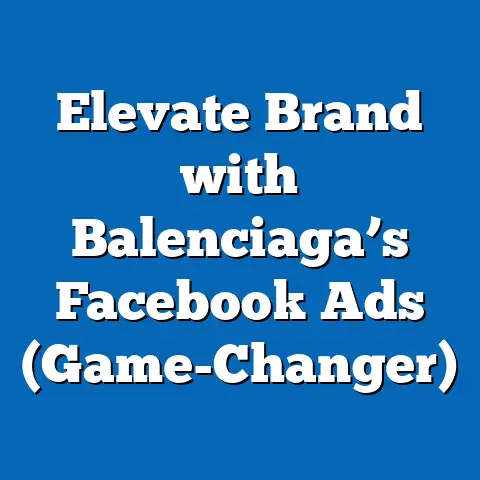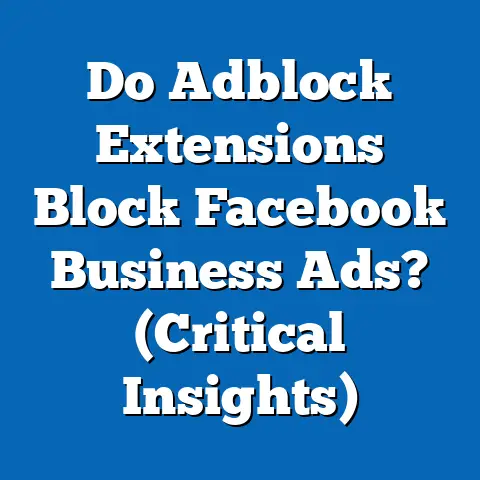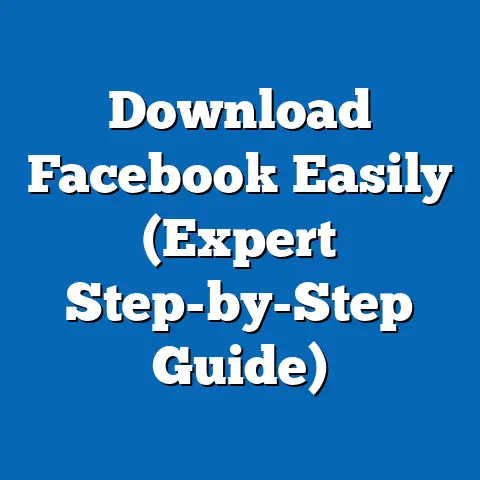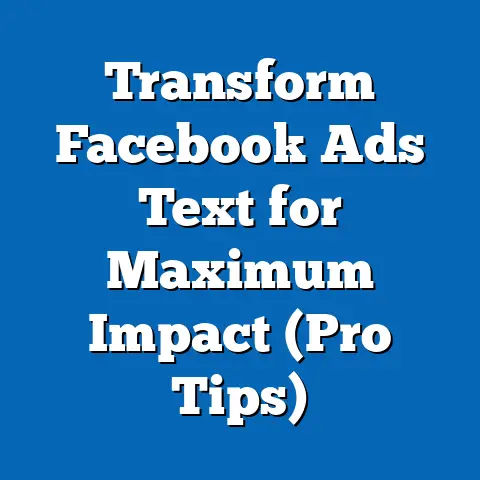Mastering Facebook Ad Objectives (Essential Guide)
Imagine driving through a bustling city with countless billboards vying for your attention, each promising a unique destination or experience. In the digital realm, Facebook advertising operates much like this urban highway, where businesses compete for visibility amidst a sea of content, and the right “billboard”—or ad objective—can guide users to your desired outcome. Mastering Facebook ad objectives is akin to knowing which roads to take, which signs to follow, and how to appeal to the diverse drivers (or users) on this digital thoroughfare.
Facebook, with over 2.9 billion monthly active users as of 2023, remains one of the most powerful platforms for digital marketing. However, the sheer scale of its audience and the complexity of its advertising tools can overwhelm even seasoned marketers. At the heart of a successful Facebook ad campaign lies the selection of the right ad objective—a strategic choice that aligns with a business’s goals, whether it’s driving brand awareness, generating leads, or boosting sales.
Defining Facebook Ad Objectives: The Core Framework
At its core, a Facebook ad objective is the primary goal a business seeks to achieve through a specific advertising campaign on the platform. These objectives are categorized into three main stages of the marketing funnel: Awareness, Consideration, and Conversion. Each stage serves a distinct purpose, guiding advertisers in crafting campaigns that resonate with their target audience at different points in the customer journey.
The Awareness stage focuses on introducing a brand or product to a broader audience, with objectives like Brand Awareness (increasing recognition) and Reach (maximizing visibility). Consideration objectives, such as Traffic (driving clicks to a website), Engagement (encouraging likes, comments, or shares), and Lead Generation (collecting user information), aim to build interest and interaction. Finally, Conversion objectives, including Conversions (prompting specific actions like purchases), Catalog Sales (promoting products from a catalog), and Store Traffic (driving foot traffic to physical locations), target users ready to take action.
Understanding these objectives requires recognizing that they are not one-size-fits-all solutions. A small business launching a new product may prioritize Brand Awareness to build recognition, while an e-commerce retailer might focus on Conversions to drive immediate sales. The choice of objective influences ad delivery, targeting options, and even the creative elements of a campaign, making it a foundational decision in the advertising process.
Historical Context: The Evolution of Facebook Advertising
To fully grasp the significance of ad objectives, it’s essential to trace the historical evolution of Facebook advertising. Launched in 2004 as a social networking platform for college students, Facebook initially had no advertising component. It wasn’t until 2007 that the platform introduced its first ad product, “Facebook Flyers,” allowing businesses to target users based on demographic data—a revolutionary concept at the time.
Significant societal events also shaped the trajectory of Facebook advertising. The 2016 U.S. presidential election and the subsequent Cambridge Analytica scandal in 2018 raised concerns about data privacy and the ethical use of targeted ads, prompting Facebook to refine its policies and transparency measures. Meanwhile, the rise of mobile internet usage—over 98% of Facebook users access the platform via mobile devices as of 2023—shifted ad objectives toward mobile-friendly formats like Stories and video content.
These historical developments highlight how technological innovation, user behavior, and regulatory pressures have continuously reshaped Facebook’s advertising landscape. Ad objectives, as a result, have evolved from basic visibility goals to complex, outcome-driven strategies that reflect the platform’s role in a hyper-connected world.
Key Characteristics of Facebook Ad Objectives
Each Facebook ad objective comes with distinct characteristics that influence how campaigns are designed and measured. Let’s explore the primary categories and their defining features, drawing on data and platform insights.
-
Awareness Objectives: These are designed to cast a wide net, prioritizing impressions over immediate action. Brand Awareness, for instance, optimizes for users likely to recall an ad, often measured through estimated ad recall lift—a metric indicating how many people would remember seeing the ad if asked. Reach, on the other hand, focuses on showing the ad to as many unique users as possible, ideal for local businesses or event promotions.
-
Consideration Objectives: This category bridges the gap between awareness and action, encouraging users to engage with a brand. Traffic objectives drive clicks to external websites or apps, while Engagement objectives measure interactions like post reactions or comments, often boosting organic reach. Lead Generation, a powerful tool for B2B marketers, uses custom forms to collect user data directly within the platform, minimizing friction in the process.
-
Conversion Objectives: These are the most action-oriented, focusing on measurable outcomes. The Conversions objective, for example, requires setting up a Facebook Pixel—a tracking code that monitors user actions like purchases or sign-ups on a website—to optimize for specific results. Catalog Sales leverages dynamic ads to showcase products tailored to user interests, while Store Traffic targets users near physical locations using geolocation data.
A critical characteristic across all objectives is their reliance on Facebook’s algorithm, which uses machine learning to predict user behavior and deliver ads to those most likely to fulfill the chosen goal. However, this also introduces variability; outcomes can differ based on audience targeting, creative quality, and budget allocation. According to a 2022 study by Hootsuite, campaigns with well-aligned objectives and creative elements see up to a 30% higher return on ad spend (ROAS), underscoring the importance of strategic planning.
Societal Implications: The Broader Impact of Facebook Ad Objectives
The use of Facebook ad objectives extends beyond individual businesses, influencing societal dynamics in profound ways. As advertising becomes increasingly personalized, it shapes consumer behavior, cultural trends, and even political discourse. Below, we explore these implications across several domains.
Economic Impact: Empowering Businesses and Widening Gaps
Facebook ad objectives have democratized advertising by allowing businesses of all sizes to reach global audiences with relatively low budgets. Small businesses, in particular, benefit from objectives like Store Traffic and Lead Generation, which enable hyper-local targeting and cost-effective customer acquisition. A 2021 report by Meta (Facebook’s parent company) found that 70% of small businesses using the platform reported increased sales due to targeted campaigns.
However, this accessibility also amplifies disparities. Larger corporations with bigger budgets can leverage advanced objectives like Conversions with sophisticated retargeting strategies, often outpacing smaller competitors. Additionally, the reliance on data-driven objectives raises concerns about market saturation, as businesses in competitive niches struggle to stand out amidst rising ad costs—cost-per-click (CPC) on Facebook increased by 17% year-over-year in 2022, per WordStream data.
Cultural Influence: Shaping Perceptions and Values
Ad objectives play a role in shaping cultural narratives by determining which messages reach which audiences. Brand Awareness campaigns, for instance, often prioritize emotional storytelling to build affinity, influencing how consumers perceive societal values like sustainability or inclusivity. A 2020 study by Kantar found that 68% of consumers expect brands to take a stand on social issues, a trend amplified by targeted ads that resonate with specific demographics.
Yet, this personalization can also create echo chambers, where users are repeatedly exposed to content aligning with their existing beliefs. Engagement objectives, which prioritize user interaction, may inadvertently promote divisive or sensational content if it garners more clicks and shares. This phenomenon, often termed “filter bubbles,” underscores the cultural responsibility of advertisers when selecting objectives.
Privacy and Ethical Concerns
The precision of Facebook ad objectives relies heavily on user data, raising significant privacy concerns. Objectives like Conversions and Lead Generation track user behavior across platforms, often without explicit consent, fueling debates over data ethics. The 2018 Cambridge Analytica scandal, where user data was misused for political ads, highlighted the risks of unchecked targeting capabilities.
In response, regulatory frameworks like the European Union’s General Data Protection Regulation (GDPR) and Apple’s App Tracking Transparency (ATT) have imposed stricter rules on data collection, impacting how ad objectives function. A 2023 survey by eMarketer revealed that 54% of marketers reported reduced campaign effectiveness post-ATT due to limited tracking, pushing businesses to adapt to privacy-first advertising models.
Workplace and Marketing Industry Shifts
The complexity of mastering ad objectives has transformed the marketing industry, creating demand for specialized roles like digital strategists and data analysts. Companies now invest heavily in training employees to navigate tools like Ads Manager, with 62% of marketers citing platform-specific skills as critical, according to a 2022 LinkedIn report. This shift reflects a broader trend toward data literacy in the workplace.
Moreover, the focus on measurable outcomes through Conversion objectives has redefined success metrics, moving away from vanity metrics like impressions to tangible results like sales or leads. While this fosters accountability, it also pressures marketers to prioritize short-term gains over long-term brand building, a tension that requires strategic balance.
Technological and Social Factors Shaping Ad Objectives
Several external forces influence how Facebook ad objectives are designed and utilized, reflecting broader technological and social trends. Understanding these factors provides context for their current state and future trajectory.
-
Technological Advancements: The rise of artificial intelligence (AI) and machine learning has enhanced the precision of ad delivery, allowing objectives like Conversions to predict user intent with remarkable accuracy. However, innovations like augmented reality (AR) ads and interactive formats are pushing objectives toward more immersive experiences, particularly for Engagement and Brand Awareness campaigns.
-
Social Media Usage Patterns: As younger generations like Gen Z gravitate toward visual platforms like Instagram and TikTok, Facebook has adapted its objectives to emphasize video and Stories content. A 2023 Pew Research study noted that 67% of Gen Z users prefer short-form video, influencing how objectives like Traffic incorporate dynamic creatives to capture attention.
-
Economic Pressures: Inflation and economic uncertainty, as seen in the post-COVID-19 era, have shifted advertiser priorities toward Conversion objectives that deliver immediate ROI. This trend, while pragmatic, risks neglecting upper-funnel strategies like Awareness, which are crucial for long-term growth.
-
Cultural Shifts: Growing consumer awareness of data privacy and ad fatigue—where users ignore repetitive ads—has prompted a reevaluation of targeting strategies. Objectives like Engagement now focus on authentic, value-driven content to combat skepticism, with 73% of users favoring ads that feel personalized yet non-intrusive, per a 2022 Nielsen report.
Comparing Ad Objectives Across Campaign Goals
While each ad objective serves a unique purpose, comparing their applications reveals trade-offs and synergies. Awareness objectives, for instance, excel at building a foundation for brand recognition but often lack direct measurability compared to Conversion objectives. A campaign combining Reach with Conversions can balance visibility and action, though it requires careful budget allocation to avoid diluting impact.
Consideration objectives like Engagement offer a middle ground, fostering community interaction that can amplify organic reach—a cost-effective strategy for budget-constrained businesses. However, over-reliance on Engagement can skew metrics toward superficial interactions rather than meaningful outcomes, unlike Lead Generation, which prioritizes actionable data.
These comparisons highlight the importance of aligning objectives with overarching business goals while recognizing the diversity of outcomes within each category. A B2C retailer might pair Catalog Sales with Traffic to drive both interest and purchases, whereas a nonprofit might lean on Engagement and Lead Generation to build supporter networks. The key lies in testing and iterating, as no single objective guarantees success across contexts.
Nuances and Diversity in Application
It’s critical to acknowledge that the effectiveness of ad objectives varies based on industry, audience demographics, and regional factors. For example, Brand Awareness campaigns may resonate differently in emerging markets with lower digital literacy compared to tech-savvy regions like North America or Europe. A 2021 Statista report noted that ad recall rates in Asia-Pacific lag 15% behind Western markets, suggesting cultural and access-related nuances in campaign impact.
Similarly, audience diversity within a single market influences objective selection. Older demographics (Baby Boomers, Gen X) may respond better to straightforward Conversion ads with clear calls-to-action, while younger users (Millennials, Gen Z) often engage with creative, story-driven content under Engagement objectives. Marketers must tailor strategies to these differences, avoiding a one-size-fits-all approach.
Forward-Looking Insights: The Future of Facebook Ad Objectives
As we look ahead, several trends and uncertainties will shape the evolution of Facebook ad objectives. The ongoing shift toward privacy-first advertising, driven by regulations and user demand, will likely prioritize contextual targeting over personal data, potentially reshaping objectives like Conversions. Meta’s investment in the Metaverse also hints at new immersive ad formats, which could redefine Awareness and Engagement goals through virtual experiences.
Economic volatility may continue to push advertisers toward short-term, results-driven objectives, though experts like digital strategist Amy Porterfield advocate for a balanced approach that nurtures brand loyalty alongside conversions. “The future of advertising isn’t just about selling; it’s about connecting in meaningful ways,” Porterfield noted in a 2023 podcast, emphasizing the enduring value of upper-funnel strategies.
Uncertainties remain, particularly around regulatory changes and platform competition. If stricter data laws emerge, or if platforms like TikTok continue to capture younger audiences, Facebook may need to innovate its objectives to retain advertiser interest. Marketers, in turn, must stay agile, leveraging analytics to adapt to shifting landscapes.
Conclusion: Charting a Course Through Digital Advertising
Mastering Facebook ad objectives is both an art and a science, requiring a deep understanding of their characteristics, historical context, and societal impact. From empowering small businesses to shaping cultural narratives, these objectives wield immense influence, yet they come with ethical and practical challenges that demand careful navigation. By aligning objectives with business goals, embracing technological trends, and respecting user privacy, marketers can harness their potential to drive meaningful outcomes.
As the digital highway continues to evolve, so too will the tools and strategies that guide us along it. While uncertainties loom, the principles of strategic planning, audience empathy, and adaptability remain steadfast. By mastering Facebook ad objectives today, businesses not only position themselves for current success but also lay the groundwork for future innovation in an ever-changing digital landscape.





